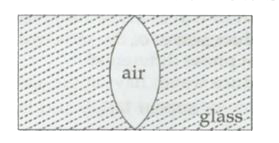The amount of air present in the cylinder when a vacuum pump removes each time 14 of the Air remaining in the cylinder. Will the sequence form an A.P. ?
To determine whether the sequence formed by the amount of air remaining in the cylinder after each operation of the vacuum pump is an Arithmetic Progression (AP), we can follow these steps:
1. Initial Volume of Air:
Let the initial volume of air in the cylinder be V.
2. First Operation:
The vacuum pump removes 14 of the air remaining.
Therefore, the amount of air remaining after the first operation is:
V1=V−14V=34V
3. Second Operation:
Again, the vacuum pump removes 14 of the air remaining:
V2=V1−14V1=34V1=34×34V=(34)2V
4. Third Operation:
Continuing this process, the amount of air remaining after the third operation is:
V3=V2−14V2=34V2=34×(34)2V=(34)3V
5. General Term:
After n operations, the amount of air remaining can be expressed as:
Vn=(34)nV
6. Identifying the Sequence:
The sequence formed by the amounts of air remaining after each operation is:
V,34V,(34)2V,(34)3V,…
This is a geometric sequence, not an arithmetic progression.
7. Conclusion:
Since the difference between consecutive terms is not constant (it decreases multiplicatively), we conclude that the sequence does not form an AP.
Let the initial volume of air in the cylinder be V.
The vacuum pump removes 14 of the air remaining.
Therefore, the amount of air remaining after the first operation is:
V1=V−14V=34V
Again, the vacuum pump removes 14 of the air remaining:
V2=V1−14V1=34V1=34×34V=(34)2V
Continuing this process, the amount of air remaining after the third operation is:
V3=V2−14V2=34V2=34×(34)2V=(34)3V
After n operations, the amount of air remaining can be expressed as:
Vn=(34)nV
The sequence formed by the amounts of air remaining after each operation is:
V,34V,(34)2V,(34)3V,…
This is a geometric sequence, not an arithmetic progression.
Since the difference between consecutive terms is not constant (it decreases multiplicatively), we conclude that the sequence does not form an AP.
Topper's Solved these Questions
Similar Questions
The amount of air present in the cylinder when a vacuum pump removes each time 14 of the Air remaining in the cylinder. Will the sequence form an A.P. ?
View SolutionIn which of the following situations, does the list of numbers involved make an arithmetic progression, and why ?
The amount of air present in a cylinder when a vacuum pump removes 14 of the air remaining in the cylinder at a time.
View Solution
Knowledge Check
Air in a cylinder is suddenly compressed by a piston. which is then maintained at the same rosition. With the passage of time
Athe pressure decreasesBthe presseure increasesCthe pressure remains the sameDthe pressure may increase or decrease depending upon the nature of the gasAir in a cylinder is suddenly compressed by a piston, which is then maintained at the same position. With the passage of time
Athe pressure may increase or decrease depending upon the nature of the gasBthe pressure remains the sameCthe pressure decreasesDthe pressure increasesA sounding fork whose frequency is 256Hz is held over an empty measuring cylinder. The sound is faint , but if just the right amount of water is poured into the cyclinder , it becomes loud. If the optimal amount of water produce an air column of length 0.31m, then the speed of sound in air to a first approximation is
A317m/sB371m/sC340m/sD332m/s
In which of the following situations , does the list of numbers of involved make an arithmetic progression , and why ?
The amount of air present in a cylinder when a vacumm pump removes 1/4 of the air remaining in the cylinder at a time .
View SolutionIn which of the following situations, does the list of numbers involved make an arithmetic progression, and why?
(i) The taxi fare after each km when the fare is Rs 15 for the first km and Rs 8 for each additional km.
(ii) The amount of air present in a cylinder when a vacuum pump removes 1/4 of the air remaining in the cylinder at a time.
(iii) The cost of digging a well after every metre of digging, when it costs Rs.150 for the first metre and rises by Rs. 50 for each subsequent metre.
(iv) The amount of money in the account every year, when 10000 is deposited at compound interest at 8 % per annum.
View SolutionIn which of the following situations, does the list of numbers involved make arithmetic progression, and why ? (i) The taxi fare after each km when the fare is 15 Rs for the first km and Rs. 8 for each additional km. (ii) The amount of air present in a cylinder when a vacuum pump removes 1/2 of the air remaining in the cylinder at a time.
View Solutionthe presseure inside th receiver of an air pump is reduced to 1/4 of the initial pressure after 3 strokes. What will be the pressure after 8 strokes ?
View SolutionIn the figure, an air lens is cut a cylinder of glass of refractive index 1.5 . The nature of the lens is

View Solution
